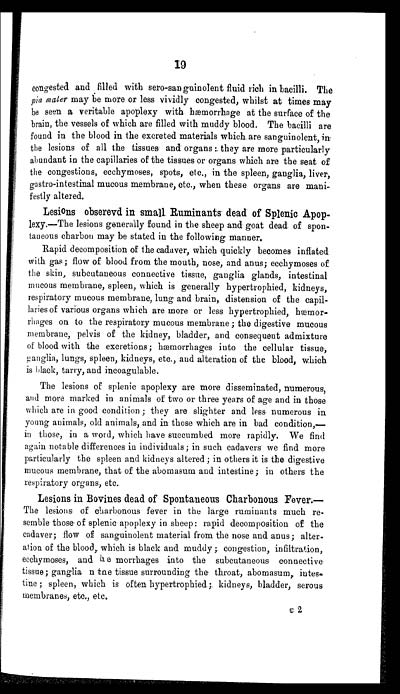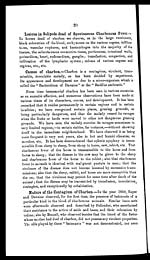Medicine - Veterinary > Civil Veterinary Departments > Civil Veterinary Department ledger series I-VI > Volume II - Anthrax
(133) Page 19
Download files
Individual page:
Thumbnail gallery: Grid view | List view

19
congested and filled with sero-san guinolent fluid rich in bacilli. The
pia mater may be more or less vividly congested, whilst at times may
be seen a veritable apoplexy with hæmorrhage at the surface of the
brain, the vessels of which are filled with muddy blood. The bacilli are
found in the blood in the excreted materials which are sanguinolent, in
the lesions of all the tissues and organs : they are more particularly
abundant in the capillaries of the tissues or organs which are the seat of
the congestions, ecchymoses, spots, etc., in the spleen, ganglia, liver,
gastro-intestinal mucous membrane, etc., when these organs are mani-
festly altered.
Lesions obserevd in small Ruminants dead of Splenic Apop-
lexy.—The lesions generally found in the sheep and goat dead of spon-
taneous charbon may be stated in the following manner.
Rapid decomposition of the cadaver, which quickly becomes inflated
with gas; flow of blood from the mouth, nose, and anus; ecchymoses of
the skin, subcutaneous connective tissue, ganglia glands, intestinal
mucous membrane, spleen, which is generally hypertrophied, kidneys,
respiratory mucous membrane, lung and brain, distension of the capil-
laries of various organs which are more or less hypertrophied, hæmor-
rhages on to the respiratory mucous membrane; the digestive mucous
membrane, pelvis of the kidney, bladder, and consequent admixture
of blood with the excretions; hæmorrhages into the cellular tissue,
ganglia, lungs, spleen, kidneys, etc., and alteration of the blood, which
is black, tarry, and incoagulable.
The lesions of splenic apoplexy are more disseminated, numerous,
and more marked in animals of two or three years of age and in those
which are in good condition; they are slighter and less numerous in
young animals, old animals, and in those which are in bad condition,—
in those, in a word, which have succumbed more rapidly. We find
again notable differences in individuals; in such cadavers we find more
particularly the spleen and kidneys altered; in others it is the digestive
mucous membrane, that of the abomasum and intestine; in others the
respiratory organs, etc.
Lesions in Bovines dead of Spontaneous Charbonous Fever.—
The lesions of charbonous fever in the large ruminants much re-
semble those of splenic apoplexy in sheep: rapid decomposition of the
cadaver; flow of sanguinolent material from the nose and anus; alter-
ation of the blood, which is black and muddy; congestion, infiltration,
ecchymoses, and he morrhages into the subcutaneous connective
tissue ; ganglia n tne tissue surrounding the throat, abomasum, intes-
tine ; spleen, which is often hypertrophied; kidneys, bladder, serous
membranes, etc., etc.
C2
Set display mode to: Large image | Zoom image | Transcription
Images and transcriptions on this page, including medium image downloads, may be used under the Creative Commons Attribution 4.0 International Licence unless otherwise stated. ![]()
| India Papers > Medicine - Veterinary > Civil Veterinary Departments > Civil Veterinary Department ledger series I-VI > Anthrax > (133) Page 19 |
|---|
| Permanent URL | https://digital.nls.uk/75516171 |
|---|




